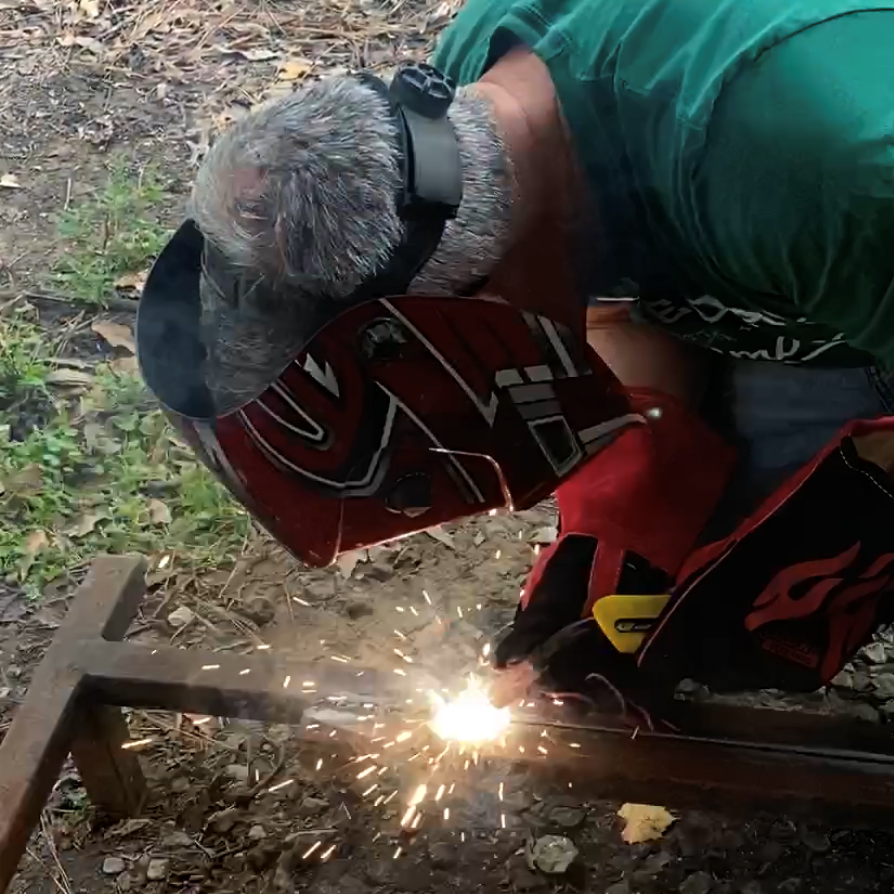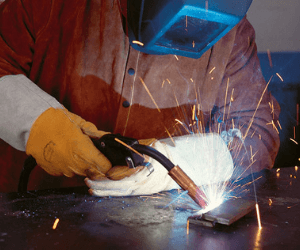As I taught my daughter how to weld, she noticed that her first few beads looked rough. She became discouraged and began complaining about the hard work it takes to learn this skill. When my grandson heard us talking, he said, “It doesn’t seem too bad from where I’m standing.”
In general, learning to weld is hard because it is an intricate process that requires plenty of practice, coordination, and commitment to master. However, the difficulty levels are different depending on the type of welding process you’re learning.
Welding can be a difficult skill to learn, but it is also an incredibly rewarding one. It can be tough to know where to begin if you are just starting out. This blog post provides some tips that will help you succeed.
Contents
Is Welding Hard?
Welding is one of the few careers that are on the rise. About 50% of everything produced worldwide needs welding (from computers to cars, from small stairs to large bridges and buildings). If there’s something with metallic components near you, there’s a welder behind it.
Because welding plays such a significant role in the production of products, learning to weld can be a tremendous benefit? Plus, learning something new doesn’t hurt anyone, and almost anyone can learn how to weld with enough patience and practice.
Anyway, whatever your reason, you’ve come to the right place to learn about welding because we’ll talk about welding, its benefits, and even its types. Before we get into the welding tips, it’s essential to know what makes welding hard in the first place.
Why is welding hard to learn?
Welding is hard because it takes a lot of practice to get good at it. You need to be able to balance the heat and control the weld puddle. If you are not careful, you can easily create a bad weld that could lead to dangerous situations.
In order to become a successful welder, you need to have some basic skills and knowledge:
-You need to understand the various welding processes.
-You need to understand metal properties and thickness.
-You need to know how to set up your equipment correctly.
-You need to be aware of safety hazards associated with welding.
-You need to know what PPE proper personal equipment is needed for your job.
Now that you know what makes welding hard, let’s go over some basic tips that will make learning easier and safer:

10 Welding Tips
Tip #01: Practice, practice, practice!
The best way to improve your welding skills is to practice as often as possible. If you can find a welding buddy, that’s even better! The more you weld, the better you will become.
Tip #02: Use the right equipment
If you are using the wrong equipment, it will be challenging to achieve good results when welding. Make sure you are using quality products and tools in order to get the best results.
Tip #03: Follow instructions carefully
Welding can be dangerous if done incorrectly. Make sure you follow all safety instructions closely to avoid any injuries. Also, never try to weld without proper training; this is a surefire way to get hurt.
Tip #04: Use the right welding technique
There are many different types of welding techniques. Make sure you are using the right one for the project you are working on. Using the wrong approach can lead to poor results and could even damage your workpiece.
Tip #05: Take care of your equipment
Welding equipment is expensive, so it’s essential to take care of it. Make sure you are cleaning and storing your equipment properly after each use. This will help ensure that your equipment lasts longer and continues to work correctly.
I typically advise beginners to start with a 220-volt multi-process machine. The higher voltage works well for various metals, and the multi-process feature lets you learn different welding styles.
Tip #6: Wear the proper personal protective equipment for welding
Welding can be dangerous if you are not wearing the proper personal protective equipment. Ensure you wear welding gloves, a welding helmet, and other safety gear when working with metal. This will help protect you from injuries.
Tip #08: Stay focused
Welding is a precision job. You must stay focused on what you’re doing in order to produce quality welds. Don’t get distracted by anything else going on around you while you are working. A misstep can cause a severe injury to yourself or others.
Tip #09: Take care of yourself
In hot climates, drink plenty of water and take breaks often to avoid heat exhaustion. In cold temperatures, dress in layers and take frequent breaks to prevent hypothermia. Welding is a dangerous job so take appropriate steps to lower your risk of injury.
Tip #10: Use the right tools
Welding is a precise job. Make sure you are using the correct tools for the task at hand. This will help ensure that your welds are of high quality.
Now that you have some tips to help you succeed at welding, get out there and give it a try. Remember always to wear safety gear and stay focused while you work. And most importantly, have fun!
Bonus Tip: Join a welding club or class
If you want to learn more about welding, join a welding club or take a welding class. There are many resources available.
Welding can be a challenging skill to learn, but you can become a pro with practice! Follow these tips to help you succeed at welding:
The Benefits of Welding
Welding is an essential skill that can provide many benefits. Not only is it a great way to develop valuable metalworking skills, but it can also lead to interesting and exciting career opportunities.
- Welding is a great way to make repairs around the house
- It’s a great hobby for people who like to work with their hands
- Welders are in high demand, so there are plenty of job opportunities available
- Welding can be used to create all sorts of different projects, from furniture to art pieces
- It’s a very versatile skill that can be used in many industries
Welding for beginners
Learning the art of welding is helpful from a practical point of view and for the possible development of a new profession. These professionals are in demand because this type of work is an integral part of most industrial areas.
Welding Processes are used for joining materials, particularly metals and their alloys, through almost immediate fusion, followed by the solidification of the components when exposed to a source of heat.
Widely used in industry, they serve the manufacture and recovery of parts, equipment, and metallic structures. Its application ranges from small electronic components to large structures and equipment (bridges, ships, cars, among others).
For beginners, it’s better to comprehend the core types of welding procedures available, how each machine functions, and expertise in handling it. It is essential to match your main welding requirements and skills with a type of process.
This step is important to proceed with the specific options for each welding machine model. Let’s have a quick view of the most common types of welding processes:
Types of Welding and Their Processes
There are many types of welding these days. Each of these types has characteristics that make them more or less suitable for certain activities. Let’s see a little more about them below.
Manual arc welding aka Stick welding and shielded metal arc welding
Of all Industrial Welding, the one performed with the manual arc is the oldest. Also called MMA or SMAW, this is the most common process for welding in workplaces, industries, or home jobs.

An electric arc burns between an electrode and the material in this process.
No shielding gas is used in welding. The coated electrode forms a shielding gas to protect the fusion and provides additives to create the seam.
TIG
TIG Welding can also be called Gas Tungsten Welding and is considered the most challenging method and therefore requires more skill and experience to master. It requires you to regulate gas flow while simultaneously welding.
In the TIG process, the heating is obtained through an electric arc generated with the aid of a non-consumable tungsten electrode which must not melt to avoid defects or discontinuities in the weld bead.
MIG
MIG Welding or Metal Inert Gas is a type of welding considered semi-automatic.
It is commonly used in the manufacturing and automotive industries besides other types of factories.

The MIG welding process can be defined as a fusion welding process, which uses the heat of an electric arc formed between a consumable metallic electrode and the puddle.
Both the arc and the weld pool are protected from contamination by the atmosphere by a gas or a mixture of gases. This is the preferred method for beginners to learn.
Flux-cored wire welding
Considered the fastest method of Industrial Welding, Arc Welding with flux-cored wire is the most common process and applied in the most diverse industries and professional areas.
The flux-cored shielded wire process is defined as a process of fusion welding, where the heat needed to bond the parts is supplied by an electric arc established between the metal pieces and a wire fed continuously.
Oxygas welding
Oxygas welding uses energy as fuel to produce heat capable of melting the material to be worked. It usually occurs in the following way: the two metals are joined with another filler metal through a flame coming from the torch. Thus, the molten metal and filler metal form a liquid that solidifies when cooled.
Welding with Coated Electrode
Welding with coated electrodes is widely used and suitable for working with steel. The Coated Electrode causes the substances of the materials to be crushed and mixed, thus forming a homogeneous mass that binds the materials.
How to Get Started with Welding
Before working on a welding project, pull out some scrap metal pieces to work with. Using scrap will let you practice without worrying about messing up. You need to install your consumable electrode in your welder or its unique holder and attach the grounding clamp to the metal you’re going to weld.
Put on your gloves, welding helmet, and boots, and get ready to start your first project. Hold the electrode slightly above the metal at approximately 65 degrees once the arc is ignited. Guide the electrode in a tight circular motion above the metal to obtain a uniform weld trace.
Welding beads are placed end to end to each other, receive an arc, and conduct an electrode along the connecting line. Here, the movements must not be straight (along the seam) but oscillatory (right, then left).
After cooling, the outer slag layer is knocked out with a chipping hammer, and the quality of the bead is visually evaluated. A good weld should be the same thickness, with no visible voids and crevices.
After practicing for an hour or two, most novice welders can strike an arc and keep it burning.
Where Can you Learn About Welding, (on-the-job training, union apprenticeships, welding schools)?
You can learn to weld by reading a basic DIY (DIY) book on the subject or attending a workshop class. Private programs, union apprenticeships, and educational courses taught at trade schools are ways to learn to weld at a reasonable rate.
Unions are a great place to gain welding experience. Most have an apprenticeship program and offer outstanding benefits and opportunities to advance.
In classes, you can learn the various tools of the trade, study standard techniques, and squeeze in some practice time as well. Many people learning to weld may also choose to earn a welding degree to enhance job opportunities and gain a deeper knowledge of the trade.
A few weeks of training provides enough knowledge for low-skill welding work. In addition, several years of experience can help you land a highly qualified job.
